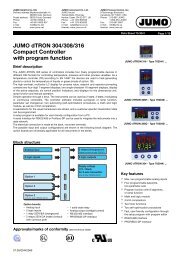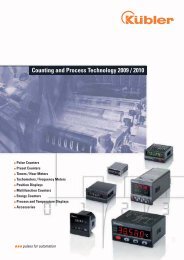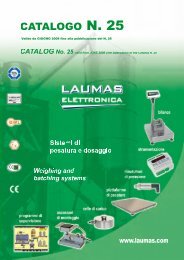Twido Programmable controller
Twido programmable controller - Mejdaf Group
Twido programmable controller - Mejdaf Group
- No tags were found...
You also want an ePaper? Increase the reach of your titles
YUMPU automatically turns print PDFs into web optimized ePapers that Google loves.
Presentation<br />
description 4<br />
<strong>Twido</strong> programmable <strong>controller</strong> 4<br />
AS-Interface actuator/sensor bus<br />
AS-Interface master module<br />
. Presentation<br />
AS-Interface master module TWD NOI 10M3 allows<br />
the <strong>Twido</strong> <strong>controller</strong> (version u 2.0) to perform the<br />
function of AS-Interface master.<br />
The AS-Interface consists of a master station (<strong>Twido</strong><br />
<strong>controller</strong>) and slave stations. The master, which<br />
supports the AS-Interface pro le, polls each of the<br />
devices connected to the AS-Interface, in turn, and<br />
stores information gathered (sensor/actuator status,<br />
operating status of the devices) in the <strong>controller</strong><br />
memory. Communication on the AS-Interface is<br />
managed in a way that is totally transparent to the<br />
<strong>Twido</strong> application program.<br />
The TWD NOI 10M3 master module manages the<br />
following with the AS-Interface M3 pro le:<br />
b discrete slave modules (maximum of 62 slaves<br />
arranged in 2 banks, A and B, of 31 addresses each),<br />
b analogue slaves (maximum of 7 slaves in bank A).<br />
The AS-Interface M3 pro le supports analogue pro le<br />
7.3 (7 slaves), but does not support analogue pro le<br />
S-7.4.<br />
The maximum number of TWD NOI 10M3 modules per<br />
<strong>Twido</strong> <strong>controller</strong> is 2.<br />
An AS-Interface power supply is essential to supply the<br />
various modules on AS-Interface. It should preferably<br />
be located close to the stations with high power<br />
consumption.<br />
6<br />
1<br />
4<br />
5<br />
2<br />
3<br />
7<br />
Description<br />
Module TWD NOI 10M3 takes the form of a standard-size module. It is connected to<br />
a <strong>Twido</strong> base <strong>controller</strong> (compact or modular) in the same way as any I/O module.<br />
It has the following on the front panel:<br />
1 A display block comprising:<br />
b 6 pilot lights indicating the module operating modes:<br />
v green PWR pilot light: module powered up,<br />
v red FLT pilot light: error in the con guration loaded,<br />
v green LMO pilot light: module in local mode,<br />
v green CMO pilot light: module in connected mode,<br />
v red CNF pilot light: not used,<br />
v red OFF pilot light: module in protected, unconnected mode.<br />
b 6 green pilot lights, 3 for inputs, 3 for outputs.<br />
2 A block for displaying the status of the addresses.<br />
3 Two pushbuttons PB1 and PB2 for controlling the status of the slaves by selecting<br />
their address and changing the mode.<br />
4 An extension connector for electrical connection to the previous module.<br />
5 A connector (on the RH side) for I/O expansion modules TWD Dpp and TWD App<br />
(4 or 7 depending on version).<br />
6 A latching mechanism for attachment to the previous module.<br />
7 A power supply removable screw terminal block.<br />
Expansion module TWD NOI 10M3 can be mounted as standard on symmetrical<br />
5 rail. Fixing kit TWD XMT5 (sold in lots of 5) allows plate or panel mounting.<br />
72







